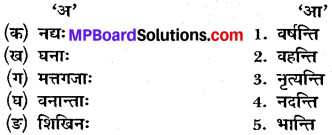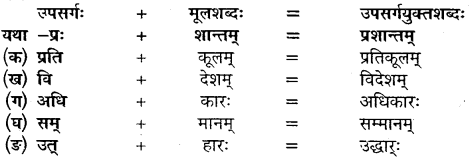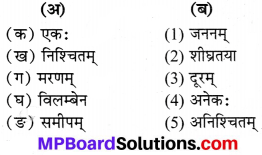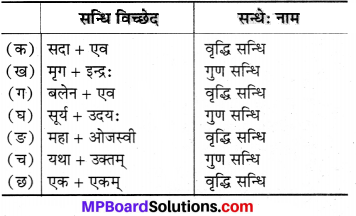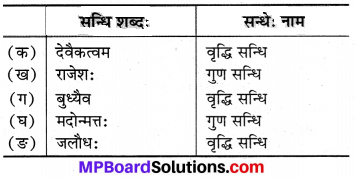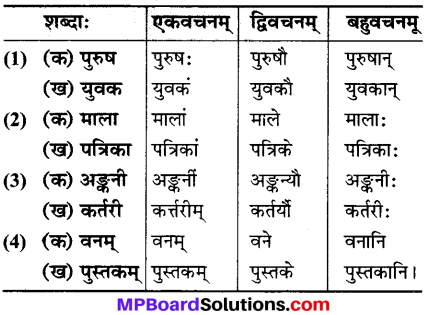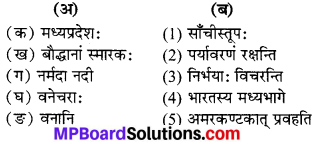MP Board Class 7th Social Science Solutions Guide Pdf Free Download सामाजिक विज्ञान in both Hindi Medium and English Medium are part of MP Board Class 7th Solutions. Here we have given Madhya Pradesh Syllabus MP Board Class 7 Social Science Book Solutions Samajik Vigyan Pdf.
MP Board Class 7th Social Science Book Solutions in Hindi Medium
- Chapter 1 भारत और विश्व
- Chapter 2 दक्षिण भारत के राज्य (800 ई. से 1200 ई. तक)
- Chapter 3 उत्तर भारत के राज्य (800 ई. से 1200 ई. तक)
- Chapter 4 हमारा संविधान
- Chapter 5 मौलिक अधिकार और कर्त्तव्य
- Chapter 6 केन्द्र की सरकार
- Chapter 7 पृथ्वी की गतियाँ
- Chapter 8 वायुमण्डल
- Chapter 9 तापमान
- Chapter 10 वायुदाब और पवन
- Chapter 11 दिल्ली सल्तनत
- Chapter 12 सल्तनतकालीन प्रशासन एवं जनजीवन
- Chapter 13 मुगल साम्राज्य की स्थापना एवं उत्कर्ष
- Chapter 14 वैभव एवं विलासिता का युग
- Chapter 15 राष्ट्रपति एवं केन्द्रीय मन्त्रि-परिषद
- Chapter 16 राज्य की सरकार
- Chapter 17 राज्यपाल एवं राज्य मन्त्रि-परिषद
- Chapter 18 आर्द्रता एवं वर्षा
- Chapter 19 मौसम और जलवायु
- Chapter 20 जलमण्डल
- Chapter 21 समुद्र की गतियाँ
- Chapter 22 औरंगजेब तथा मुगल साम्राज्य का पतन
- Chapter 23 मुगलकालीन प्रशासन तथा जनजीवन
- Chapter 24 सिक्ख एवं मराठा शक्ति का उत्कर्ष
- Chapter 25 हमारी न्यायपालिका
- Chapter 26 बाल अधिकार एवं मानव अधिकार
- Chapter 27 भारत की जनजातियाँ
- Chapter 28 एशिया महाद्वीप : भौगोलिक स्वरूप
- Chapter 29 एशिया महाद्वीप : आर्थिक स्वरूप
- Chapter 30 यूरोप महाद्वीप : भौगोलिक स्वरूप
- Chapter 31 यूरोप महाद्वीप : आर्थिक स्वरूप
- Chapter 32 अफ्रीका महाद्वीप : भौगोलिक स्वरूप
- Chapter 33 अफ्रीका महाद्वीप : आर्थिक स्वरूप
- विविध प्रश्नावली 1
- विविध प्रश्नावली 2
- विविध प्रश्नावली 3
MP Board Class 7th Social Science आदर्श प्रश्न-पत्र
MP Board Class 7th Social Science Book Solutions in English Medium
- Chapter 1 India and the World
- Chapter 2 Kingdoms of the South India
- Chapter 3 Kingdoms of the North India
- Chapter 4 Our Constitution
- Chapter 5 Fundamental Rights and Duties
- Chapter 6 Government at the Center
- Chapter 7 Movements of the Earth
- Chapter 8 Atmosphere
- Chapter 9 Temperature
- Chapter 10 Air Pressure and Wind
- Chapter 11 The Delhi Sultanate
- Chapter 12 Administration and Life of the People during the Sultanate Period
- Chapter 13 The Foundation of the Mughal Empire and its Rise
- Chapter 14 The Age of Magnificence
- Chapter 15 The President and the Central Council of Ministers
- Chapter 16 State Government
- Chapter 17 The Governor and State Council of Ministers
- Chapter 18 Humidity and Rainfall
- Chapter 19 Weather and Climate
- Chapter 20 Hydrosphere
- Chapter 21 Sea Movements
- Chapter 22 Aurangzeb and the Decline of the Mughal Empire
- Chapter 23 The Administration of the Mughal and the Life of the People
- Chapter 24 The Rise of the Sikh and Maratha Power
- Chapter 25 Our Judicial System
- Chapter 26 Rights of a Child and Human Rights
- Chapter 27 The Tribes of India
- Chapter 28 Asia: Physical Features
- Chapter 29 Asia: Economic Resources
- Chapter 30 The Continent of Europe: Physical Features
- Chapter 31 Europe: Economic Features
- Chapter 32 The Continent of Africa: Physical Features
- Chapter 33 Africa: Economic Development
- Miscellaneous Questions 1
- Miscellaneous Questions 2
- Miscellaneous Questions 3
MP Board Class 7th Social Science Model Question Paper
We hope the given MP Board Class 7th Social Science Solutions Guide Pdf Free Download सामाजिक विज्ञान in both Hindi Medium and English Medium will help you. If you have any query regarding Madhya Pradesh Syllabus MP Board Class 7 Social Science Book Solutions Samajik Vigyan Pdf, drop a comment below and we will get back to you at the earliest.

